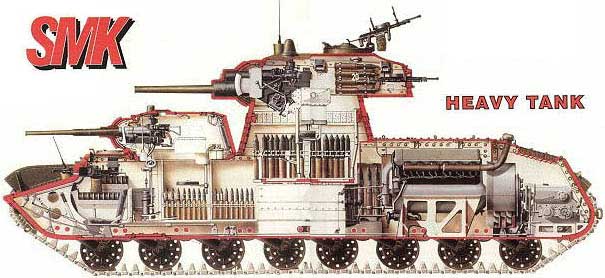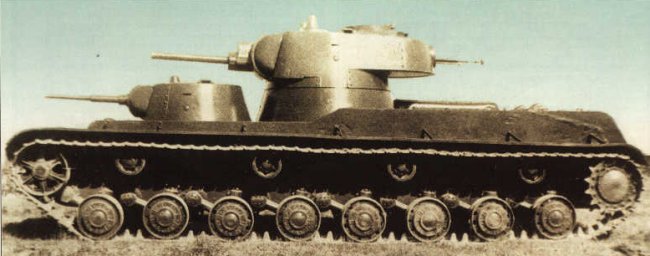Kiireellinen tehtävä annettiin Leningradin Kirov panssarivaunutehtaalle.
Tehtaan Johtajana toimi I M Salzman.
Leningardissa toimi myös erikois-suunnittelutoimisto 2 (venäläinen lyhenne SKB-2).
Sitä johti insinööri J Kotin, joka siirrettiin Kirovin tehtaaseen johtamaan kaikkea panssarialan kehitystä.
Uusi projekti sai nimen SMK (Sergei Mironovits Kirov) kaupungin ex-johtajalta, jonka Stalin oli murhauttanut jo 1934.
Uutta projetkia johti ins. A S Jermolajev yhteistoiminnassa Kotinin kanssa.
Näille uusille vaunu-tyypeille annettiin prototyyppien valmistumisen ajankohdan määräpäivä 1939 elokuu johon mennessä niiden tuli olla valmiina esiteltäväksi.
SMK Pansaarivaunussa oli teräs telapyörät, vaunu painoi 56 tonnia ja siinä oli sauvajousitus, joka nyt otettiin NL:ssä ensimmäistä kertaa käyttöön.
SMK päätornissa oleva vaunun johtajan kupu oli pyöreä ja kartiomalli.

Prototyyppien valmistuttua SMK, T-100 ja KV-1 tankit vietiin syyskuussa moskovan lähistölle, jossa olivat myös Harkovin veturitehtaan uudet mallita sekä käytössä olevat parannetut mallit kuten T-26S ja BT-7M.
Vaunut esiteltiin ylimmälle sotaneuvostolle, jonka puheenjohtajana toimi NL:n marsalkka K Voroshilov muina jäseninä mm A Zahdanov, sekä A Mikojan.
Voroshilo oli vaikuttunut nimensä saaneesta vaunusta (Kliment Voroshilov = KV-1).
Kliment Voroshilov / Andrei Zhdanov / Anastas Mikoyan
Marraskuun 30 päivän hyökkäysten ankarissa taisteluissa T35 ja T28 vaunut eivät saaneet murtoa aikaan. Puna armeijan hyökkäykseen oli tuotu nämä uusimmat vaunutyypit, miehistöinä toimi tehtaista koottu ja osin puna-armeijasta määrätty,
jotka oli kolutettu Tsarskoje Selo. Annetun vaunujen vaunujen pika koulutus käytön jälkeen, joka sisälsi myös maasto ajoa ja ampumaharjoituksia, heti komennettu Suomen Karjalan Kannas rintamalle.
Koska T-28 ja T-35 vaunut ei pystyneet rikkomaan suomen rintamaa, kokeiltiin myös uusia vaunuja.
Nämä vaunut tuotiin maantietä ajamalla Leningradin tehtaalta, suoraan rintamalle.
Joulukuun 17 päivän hyökkäyksiin osallistui muiden satojen panssarien lisänä nämä SMK, sekä KV-1 tyypin vaunut. Käytännön kokemukset eivät olleet myönteisiä T-100
ja SMK vaunuille.
Joten: näiden SMK ja T-100 panssarivaunujen sarjavalmistusta ei koskaan aloitettu.
T-100 vaunusta rakennettiin SU-100 rynnäkkötykki suomen linnoituksia vastaan kokeiltavaksi, joka osallistui myös muihin talvisodan taisteluihin.
Yksi SMK vaunuista ajoi suomalaisten asemien sisään, pysähtyi sinne seisahtuneena joidenkin näissä vaunuissa esiintyvien monien teknisten vikojen johdosta.
Tästä vaunusta suomalaiset ottivat kolme valokuvaa.
Tehokasta hinauskalustoa suomella ei ollut jonka vuoksi vaunua ei voitu hinata omalle puolelle korjattavaksi.
Mikäli paikalle olisi saatu asiantuntevia panssarimiehiä, he olisivat ekä saaneet moottorin käymään ja vaunun ajettua omien puolelle, lähempää tutustumista varten.

---------------------------------------------
SMK was an armored vehicle prototype developed by the Soviet Union prior to the Second World War.
The SMK was mistakenly known to German intelligence as the T-35C.

SMK was an armored vehicle prototype developed by the Soviet Union prior to the Second World War.
The SMK was mistakenly known to German intelligence as the T-35C.
Only one was built and after a poor showing against other designs and brief use in the war with Finland, the project was dropped

(named after Sergei Mironovich Kirov - the recently assassinated party official)
The Stalin orders, murdered in 1934 in Leningrad mayor of Sergei Kirov Mironovich.
The SMK was among the designs competing to replace the unreliable and expensive T-35 multi-turreted heavy tank. A design team under Kotin at the Kirovski Works (formerly the Putilov Works) at Leningrad designed the tank. Competition came from the former OKMO designer N. Barykov at the Bolshevik Plant.
----------------------

Type: Heavy tank
Place of origin: Soviet Union
Service history
In service: 1939 (prototype)
Used by: Soviet Union
Wars: Winter War
Production history: Manufacturer Kirov Plant
Produced: 1939
Number: built 1
Weight: 56 t
Length: 970 cm
Width: 320 cm
Height: 347 cm
Track width: 55 cm
Crew: 7
Armor: Front 60 mm
Armament: Big turret, 76,2 mm gun + 2x DT mg, Small turret 45 mm gun+ 1×7.62 mm DT mg + i x 7,62 mg front.
Engine: GAM-34BT V-12 otto, bensiini 850 hp/ 625 kw.
Power/weigh:t 15.5 hp/t
Suspension: torsion bar
Ground clearance: 60 cm (1 ft 8 in)
Fuel capacity: 1320 liter
Range: 220 km
Speed: 35 km/h
---------------------------------------------------
Russian mention info no tell these kind of information this tank engines
V-12 intake 400 hp / 294 kw or 500 hp / 368 kW this tank.
These info is west sides
----------------------------------
In spite of the lessons that could have been learned during the Spanish Civil War, the specification drawn up for the "Anti-Tank Gun Destroyer" in 1937 required the ability to withstand 45 mm anti-tank guns at point-blank range and 75 mm artillery fire at 1,200 m (1,300 yd).

Meetings in 1938 reduced the number of turrets in the specification and a move to torsion bar from spring suspension. Kotin and his assistant independently designed a single-turret version of the SMK which received Stalin's approval and the name KV. Production of two prototypes was ordered.
The SMK's armament was a short 76.2 mm gun in the upper centrally placed turret and a 45 mm weapon in the forward turret

The SMK, the two KV-1 prototypes and the two T-100 prototypes were put through proving trials before being tested operationally in combat during the Winter War against Finland. The vehicles formed a company of the 91st Tank Battalion of the 20th Heavy Tank Brigade. The unit was under the command of the son of the Defence Commissar. After being immobilized by a mine, the SMK had to be abandoned and was not recovered for 2 months.
The KV design proved superior in both trials in Finland and was accepted.



I like the twin turrets!
VastaaPoistaHi
PoistaTwo tower models are handsome.
Represented good old times ideas
Like to us today represent more than 20 yr old passenger